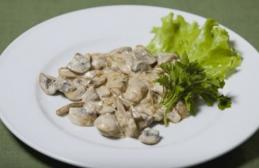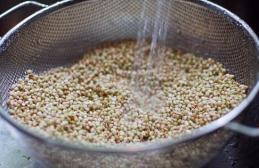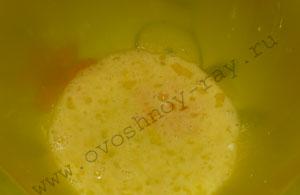High-quality noodles bought in a store can be prepared at home, for example, by cooking a delicious soup with them, or by boiling them separately and serving them with some sauce, with meat, fish, vegetable dishes, mushrooms, or. It’s even tastier to cook all these dishes with homemade noodles.
Homemade noodles taste better, at least, not only because you make them yourself, but also because you strive to use the highest quality products and do everything in the best possible way.
Homemade noodles are made from thinly rolled dough by hand using a knife or using a homemade noodle cutter (a very useful device for such a case; some people even have such devices at home from Soviet times).
We'll tell you about recipe options for preparing dough for homemade noodles, from which you can prepare the most delicious and healthy dishes at home.
Dough for homemade noodles can be made not only from wheat flour, but also from a mixture of wheat flour with flour from various other grains, with additives if you wish. Such noodles will contain significantly less gluten (which is contraindicated for some); in addition, for example, buckwheat noodles are interesting not only for fans of Pan-Asian cuisine, but are also very suitable for nutrition for diabetes and excess weight problems.
The simplest dough for homemade noodles made from flour and water without eggs - recipe
Ingredients:
- whole grain spelled or wallpaper flour - approximately 2 measures;
- water – 1 measure.
Preparation
Knead the dough from sifted flour and cold clean water (you can use a mixer with a spiral attachment). Mix thoroughly. The dough should be quite stiff. Roll out the dough into thin layers and make noodles with a knife or using a noodle cutter. Do not scatter the noodles too closely - spread the noodles in one layer to dry on clean paper, at least for 3 hours. Homemade noodles are cooked until al dente for about 5 to 8 minutes.
If you want to increase the healthfulness of the noodles, you can take 2 measures of wheat flour and mix with 1 measure of oatmeal and/or barley. If you do not find barley flour on sale, you can get it by grinding ordinary pearl barley in a home mill such as a coffee grinder.
Egg noodle dough - recipe
Ingredients:
- wheat flour or mixed with oatmeal and/or barley – approximately 2 cups of 250 ml;
- water – 1 glass;
- chicken egg – 1 pc.
Preparation
Knead the dough from sifted flour and cold clean water. Add an egg. Knead thoroughly, but not for long, using a mixer with a spiral attachment at low speed. Roll out the dough into a thin layer and cut the noodles using a knife or noodle cutter. Place the noodles on a sheet of paper and let them dry (see above).
Egg noodles are more filling and high-calorie than simple noodles; they are also remarkable because they are less mushy during the cooking process. Cook the egg noodles until al dente, about 8-10 minutes.
People in China love noodles, where they are prepared from the flour of various cereals and even from the flour of legumes. Rice and buckwheat noodles are especially popular in China.
Dough for Chinese - homemade recipe
Ingredients:
- buckwheat flour – 1 measure;
- wheat flour – 1 measure;
- water – 1 measure.
Preparation

Mix wheat and buckwheat flour, sift and knead the dough with water (or with the addition of an egg); if you want to make the noodles lighter, you can add rice or corn starch, but not more than 1/4 of the total volume. Roll out the dough into a layer and make noodles with a knife or noodle cutter.
Homemade rice noodles are made in the same way (they are cooked for no more than 8 minutes).
You can also add ground spices (for example, a curry mixture), tomato paste, or finely grated fresh herb paste to the dough for homemade noodles, prepared according to any of the above recipes. Such additives not only give noodles new colors and tastes, but also significantly increase their healthfulness.
Homemade noodles, mixed only with eggs and flour of the highest quality, are decidedly different from store-bought counterparts, and they will cost mere pennies. Dried noodles can be stored in a paper or linen bag and used if necessary.
I will show you a simple step-by-step recipe for preparing such delicious noodles in an uncomplicated way.
Homemade noodles will definitely decorate and complement the dish if you use it instead of store-bought ones.
Flour is calculated according to the proportion: 1 egg - 100 g of flour.
Ingredients:
- a) premium flour - 200 g,
- b) chicken eggs - 2 pcs.,
- c) vegetable oil - 10 ml.

Just three ingredients!
Making homemade noodles:
1. Sift the flour through a sieve into a deep bowl. Make a well in the center and beat the eggs into it, then pour in the oil.
2. Knead the dough into a tight one - it will be difficult to knead, but at this stage you need to form a bun. Place it in a bag and let the dough rest for 10 minutes.

3. The rested dough will become more pliable and pleasant to work with. For convenience, divide the bun into 3 balls and roll each one separately. The rolled sheet should be thin and transparent, like tracing paper.

4. Transfer the finished layer to a towel to dry a little.

5. Once all the dough is rolled out and dried, you can start cutting the noodles. To prevent it from being too long, the layer can be cut in half.

6. Next, roll up the tube.

7. Holding the knife at an angle (so as not to cut your fingers), cut thin noodles.

8. The rolled noodles will begin to unwind if you lift them up and crush them with your fingers.

You can immediately use these noodles to prepare a side dish or cook soup with them in chicken broth. If you dry homemade noodles for some time, they will be perfectly stored in the cupboard until the next use.
2016-01-27
Date: January 27, 2016
Tags:
Hello my dear readers! I continue the topic of basic dough recipes that I started a long time ago. We have already mastered, familiarized ourselves with, cooked, and today the recipe for dough for homemade noodles is next.
In the cuisine of many nations, homemade noodles are present in one form or another. Of course, her “names” sound different in different languages. Mostly heard of Italian “pasta”. And here in Transcarpathia, for example, homemade noodles are called “pumped dumplings” - that is, “rolled dumplings” (as opposed to “metan” dumplings, which are similar to dumplings). Since the price of good pasta is currently going through the roof, it is worth learning how to make noodle dough yourself. Do you agree? And whether to cook simple noodles from it or with pappardelles is a matter of taste.
Our Transcarpathian women, especially in villages, masterfully, no worse than Italians, roll huge sheets that cover the entire table. Sometimes a hundred eggs are used at once. Of course, “Transcarpathian pasta” is made in such quantities mainly when any special events are coming up, such as a wedding or a crowded anniversary. Our housewives consider it shameful to buy something in a store that is easy to prepare at home.  So, we’ll start cooking too, if you don’t mind.
So, we’ll start cooking too, if you don’t mind.
Recipe for homemade egg noodles dough
Ingredients
- 100 g flour type 00.
- 1 egg.
- 20 ml water (if needed).
How to cook

Recipe for homemade noodles in a bread machine
Ingredients
- 0.5 kg flour.
- 150 ml cold water.
- 3 eggs.
- A pinch of salt.
Cooking technology
- First, put eggs, salt, and water in the bread machine bucket.
- Pour in the sifted flour, place the bucket, close the lid, and select the appropriate mode. It is different for different units. Maybe, for example, “Pasta dough” or “Unleavened pasta dough”. If there is nothing like that, then try using the “Dough for dumplings and dumplings” mode.
- After kneading is complete, roll out the noodles using the above method.
My comments

The work will be made much easier if you use a mixer for kneading and special gadgets for rolling and cutting the dough.
If you have any questions, write, I will be happy to answer them. Now our turn is to prepare various Italian pastas. Or maybe we can organize a flash mob to prepare dishes from homemade noodle dough? How do you look at this, my dear readers? If you found the information presented useful, please share it on social networks. Subscribe to my blog newsletter if you haven't already. I promise - it won't be boring! It's time to say goodbye for today. Bye everyone!
When you say “homemade noodles,” you immediately feel the comfort and warmth of your home. Previously, noodles were always prepared at home, because store shelves did not please us with a large abundance of goods. There are several ways to prepare noodles at home. For example, in Ukraine they bake white pancakes with starch, cut them into noodles and dry them. You can also make socchi from the dough, dry them in a frying pan, and then cut them into small strips.
I'll tell you how they prepare noodles in my family. It is best not to use water in the recipe, but to use only eggs. Then the broth will always be clear and there will be no large excess of sprinkled flour left. It must be said that preparing homemade noodles requires some effort; the dough is kneaded tightly and then rolled out with difficulty. But these efforts are worth it, the result will please you.
Ingredients:
I do everything my own way and first break an egg into a bowl. I stir it with a fork along with the salt. 
Then I add flour. Less than half of the flour left from the norm in the photo. It took a little more than half a bowl for the noodles. You need to stir in the flour gradually. Some were mixed in and added again. The dough should be very stiff, hard and difficult to knead. A real hand trainer. If the dough remains soft, it will stick and the finished noodles will clump together. You will still need to add flour later. Therefore, it is better to add it all at once. 
You will get a lump the size of a fist. Let it lie under a towel for 15 minutes, and then knead again so that it becomes homogeneous and does not stick to the table or hands. It won't need any more flour. 
The dough needs to be rolled out very thin. This is the most time-consuming work and requires effort. This is not dough for dumplings and dumplings; it’s hard to roll out, and your palms burn from the effort. In addition, the dough on the egg, without water, contracts like rubber. But be persistent and you will be rewarded with results. To make the process easier, you need to roll out the flatbread to a diameter of about 20 cm and grease the top with olive oil. And roll out further until very thin. In my photo the thickness is less than 1 mm. There is no need to dust anything with flour, since the dough does not stick to the table. 
For convenience, the rolled out dough can be cut into two parts. If you plan to cook long noodles, you don’t need to cut them. Simply fold the dough like a ribbon.

And cut into very thin strips.

The noodles are very docile, dry out immediately and do not stick to each other. Spread it on the table and let it dry completely. 
I got 150 grams of the finished product. Dried noodles can be stored in a linen bag or box in a cool, dry place.
Many products are sold ready-made or semi-finished. This significantly reduces the cooking time of dishes, but deprives them of their natural and natural taste, as well as rich aroma. Today we’ll talk about homemade noodles, or rather about their production and subsequent storage.
Homemade egg noodles: dough recipe
Taking care of family and friends, many housewives try to use only fresh and real products for family, friends and, especially, for children. Pasta is used in the preparation of soups, side dishes, salads and even for baking. To create homemade noodles you need the following products:
- wheat flour – 350 g;
- chicken egg – 3 pcs.;
- vegetable oil – 40 g;
- salt – 10 g.
The cooking time takes a little more than one hour, and the energy value of 100 g will be 280 kcal.
To knead the dough you will need a deep bowl. Oil is poured into it, eggs are driven in and the whole mass is shaken with quick movements of the fork in a circle. Then you should very slowly and gradually add flour to the resulting mixture to improve the process of kneading the entire dough. At first, it’s easier to use a fork to stir the mass, and then start kneading by hand.

When using a food processor, this process of creating a stiff dough will significantly reduce the time for preparing noodles and reduce the labor intensity of the entire process of creating this semi-finished product.
Having made a dense and stiff dough, it should be set aside for fifteen minutes and then kneaded again until elastic. Then put it in a plastic bag and put it in the refrigerator for half an hour.
After this time, the dough for homemade noodles should be cut into several parts, each of which should be rolled out with a rolling pin to a thickness of three to four millimeters, and left to dry for ten minutes, and then turned over to dry the other side for another ten minutes.
After starting cutting, roll the dough layer into a roll and cut the egg noodles of the required thickness across this roll, and then dry it.

These semi-finished products can be boiled immediately or stored in a jar or plastic bag.
Rice noodle dough recipe step by step
This dish can be consumed with just one addition - butter, and the noodles will still be tasty and satisfying. Rice flour, used to create semi-finished products, became known only after the Great Patriotic War. Previously, it was made only from small and broken rice, but now this flour is a fairly common and well-known product. To make your own homemade rice noodles you will need:
- rice flour – 0.5 kg;
- chicken egg – 3 pcs.;
- salt – 10 g;
- water – 30 g.
It will take one hour to knead the dough and prepare this semi-finished product, and the nutritional value of one hundred grams will be 260 kcal.

The recipe for creating noodles consists of sequentially performing the following steps:

All proportions of products must be strictly observed to ensure the correct thickness of the product.
Dough for homemade Chinese noodles
Recently, archaeologists in one of the Chinese provinces found a clay pot with the remains of noodles. This became the main proof of the love of the Chinese people for such self-prepared dough products as noodles. To create this semi-finished product you will need:
- water – 200 g;
- wheat flour – 500 g;
- salt to taste (2-3 g).
It will take two hours to create real Chinese noodles, and the calorie content of one hundred grams of the dish will be 270 kcal.

Pour the sifted flour into a heap onto the work surface to knead the dough. Make a hole in the center of the “mountain,” pour in water and begin kneading. The result should be a stiff, dense dough. Using cold water to create the noodles will also make the dough more elastic.
Wrap the resulting ball of flour in cling film and place it in the refrigerator for one hour. After this time, take out the dough and divide it into several pieces.
Roll out all parts with a rolling pin until an almost transparent layer is formed, sprinkle each of them with flour and leave to dry for ten minutes, then turn over and leave the other side to dry for the same time.

Cut homemade Chinese noodles to the required thickness, boil and taste with sour cream, butter, meat dishes and fresh salads.
How to make a semi-finished product correctly
The proper process for making homemade noodles from dough is a little different from simply rolling out the dough into a regular sheet using a rolling pin and cutting it into strips with a sharp knife.
Chinese chefs carry out all the processes to create noodles by hand. After the dough has been kneaded and left in the refrigerator for about an hour, it is rolled into a long rope. The two ends of this tourniquet are taken in both hands and, making jerky strokes, are thrown alternately down, up, and twisted to the right and left sides.
This process should be done until the dough becomes elastic and begins to tear.
Only after this is it sprinkled with flour and begin to be pulled into thin, long threads, which are the correct way to create noodles.
With the natural manual process of preparing this semi-finished product, it should be used to create a variety of dishes at once so that the noodles do not lose their appearance and taste.
Storage Features
Creating this semi-finished product is a rather difficult process that cannot be repeated every day in connection with other pressing matters around the house.

Questions that arise regarding drying homemade noodles and storing them can be resolved in the following way:
- Purchase special racks for placing noodles that require drying on them or use the backs of chairs, a clothes dryer, which must first be covered with clean linen towels;
- If the product needs to be stored for a long time, freezing is the best method. To do this, the semi-finished product is carefully laid out on a flat surface, placed in the freezer for ten minutes, and then transferred to clean, dry containers. This allows you to increase the shelf life to six months;
- Dried noodles should be brittle, hard, and dense. If these products are properly dried, storage can be done by placing the product in an airtight container, sent to the pantry or kitchen cabinet.
By spending one day creating homemade noodles, you can delight your family, friends and guests with delicious, healthy and satisfying dishes from this semi-finished product for a whole year.

The beneficial properties of homemade noodles are due to the high content of vitamins E, group B, and fiber, which are part of wheat flour. Rice noodles are considered a dietary dish and are perfect for children, people with weak immunity, and stomach problems. Buckwheat noodles contain a lot of iron and help increase hemoglobin. Homemade food is always considered the most healthy and is much more highly valued, therefore, when using a recipe for creating any noodles, you should remember that:
- When choosing flour for dough, preference should be given to first grade or wholemeal flour. This will help retain more vitamins and minerals in the product;
- For noodles, it is better to use non-carbonated mineral and chilled water - the dough will be more elastic and glossy in appearance after standing in the refrigerator;
- For the egg noodle recipe, you should use only fresh eggs - the staleness of this product will cause the dough to tear when rolled out;
- The knife for cutting noodle strips should be sharp; the dough should under no circumstances stick to it;
- The longer you knead the dough, the tastier the homemade noodles will be.
This industrially produced semi-finished product is very dangerous to health, does not contain essential vitamins and minerals, and can lead to addiction and obesity. Only the homemade method of preparing noodles is aimed at maintaining health.
Another recipe for making homemade noodles is in the next video.









